|
|
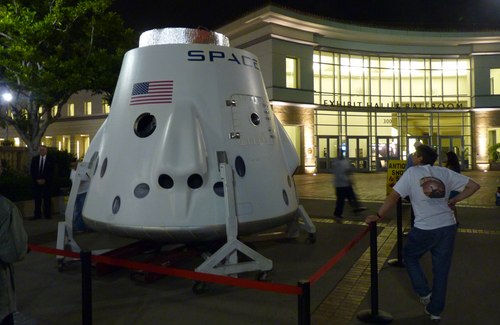 A mockup of the crewed version of the Dragon spacecraft on display in August 2012 outside the Pasadena Convention Center. SpaceX will unveil the actual crewed version of Dragon, called Draon V2, Thursday night. (credit: J. Foust) SpaceX is holding a media event tonight at 7 pm PDT (0200 GMT Friday) to unveil its Dragon “V2″ (version 2) spacecraft, one that will be capable of flying people. Elon Musk will formally unveil the spacecraft in an event at the company’s Hawthorne, California, headquarters; the event will also be webcast by SpaceX.
SpaceX hasn’t disclosed many details about how the Dragon V2 will differ from the current version of Dragon that transports cargo to and from the station, beyond obvious changes like the inclusion of seats and controls for the crew. The Dragon will feature new “SuperDraco” engines that will power its launch escape system and also be used for propulsive landings on land (versus the splashdowns in the ocean that the current Dragon performs). SpaceX announced earlier this week that it completed qualification testing of the SuperDraco thruster at its McGregor, Texas, test site. That clears the way for a pad abort test later this year, one of the last remaining milestones in SpaceX’s Commercial Crew Integrated Capability (CCiCap) award from NASA’s Commercial Crew Program.
While that pad abort test, and a later in-flight abort test, will demonstrate the SuperDraco’s ability to get the Dragon away from a malfunctioning rocket, SpaceX is also planning tests of the thruster’s ability to allowed powered landings of Dragon. Earlier this month, the FAA’s Office of Commercial Space Transportation released a draft environmental assessment report of tests of the “DragonFly” system at McGregor. The report is part of a SpaceX application for an experimental permit to cover powered test flights by the Dragon capsule: “SpaceX’s need for the experimental permit is to conduct tests to further develop the capability for the Dragon capsule to land, so that it can be reused.”
According to the test program in the report, SpaceX plans to do a pair of “propulsive assist” landing tests, where Dragon is dropped from a helicopter form an altitude of about 3,000 meters to land using a combination of parachutes and SuperDraco thrusters. That would be followed by a pair of drop tests where the dragon will use its SuperDraco thrusters alone. That will be followed by as many as 26 “hopping” tests where the capsule takes off from a pad under thrusters and land back on that pad after flying to altitudes of a little more than 2,000 meters; those landings would initial be with parachutes and later with SuperDraco thrusters. Those tests would, under the permit, be performed in one year, although SpaceX notes in the report that it expects the DragonFly program to span two years, 2014 and 2015.
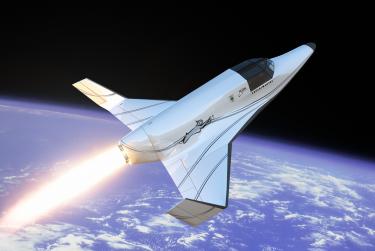 A $14-million funding round announced this week will give XCOR Aerospace the financial runway it needs to bring the Lynx suborbital spaceplane to market. (credit: XCOR Aerospace) XCOR Aerospace announced Tuesday that it has raised a “Series B” funding round of $14.2 million, led by one of its partners. Space Expedition Corporation (SXC) is taking an undisclosed stake in XCOR, enough to warrant two of its officers, Michiel Mol and Mark Hoogendoorn, to join XCOR’s current five-member board of directors. Several other existing and new investors joined in the round, including Esther Dyson and Pete Ricketts, and the company is in discussions with “a few more potential investors” who may join this summer. (An SEC filing by XCOR earlier this year indicated that the company was seeking to raise as much as $20 million.)
SXC, originally known as Space Experience Curaçao, is one of XCOR’s major customers, selling seats on future flights by XCOR’s Lynx suborbital spaceplane. SXC plans to “wet lease” Lynx vehicles from XCOR for operations from the Caribbean island of Curaçao. SXC is based in the Netherlands, and as such the investment was reviewed by the Committee on Foreign Investment in the United States (CFIUS), an office of the Treasury Department that vets foreign investments in some industries. XCOR said in the statement announcing the investment that CFIUS had cleared the investment.
The investment, according to the release, will fund XCOR’s work on Lynx to bring the suborbital spaceplane to market. The prototype Lynx Mark I is being assembled at XCOR’s Mojave facility, and company officials said earlier this month that they expect tests of that prototype to begin later this year. “This investment will allow us to accelerate and run in parallel several final developments in the critical path to first flight,” XCOR CEO Jeff Greason said in the announcement.
Once the test flight program starts for the Lynx, it will be at least a year before commercial flights will begin. In a presentation at the National Space Society’s International Space Development Conference (ISDC) in Los Angeles earlier this month, XCOR test pilot and former astronaut Rick Searfoss said he anticipated a test flight program of 12 to 18 months, depending on the progress the company makes on the incremental series of test flights.
XCOR is also getting ready to move its operations from Mojave Air and Space Port in California to Midland International Airport in Texas. Officials there said earlier this month that they’re making progress on getting a spaceport license from the FAA’s Office of Commercial Space Transportation, and expect to get approval by September 15. Work is also underway there to remodel a hangar that XCOR will use.
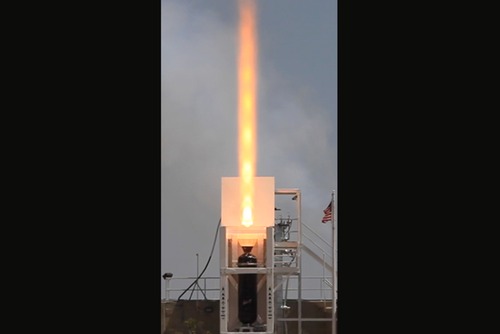 A hybrid engine using polyamide, or plastic, fuel is tested by Virgin Galactic on May 8. Virgin plans to use this in place of the rubber-based fuel originally developed to launch SpaceShipTwo into space. (credit: Virgin Galactic) After many months of speculation, including sightings of engine tests at the Mojave Air and Space Port in California, Virgin Galactic announced on Friday that it be switching to a new plastic fuel in the hybrid rocket motor that will power SpaceShipTwo on upcoming test flights.
In a statement Friday, the company said it would replace the hydroxyl-terminated polybutadiene (HTPB) solid fuel—a form of rubber—that had been in the hybrid rocket motor with a polyamide-based fuel, which the company describes as a “benign thermoplastic.” Polyamides can come in a number of forms, including nylon. That new fuel has been used in a number of ground tests, including a full-duration burn on May 8:
“There was no single thing” that caused the company to switch fuels, Virgin Galactic CEO George Whitesides said in a phone interview Friday afternoon. “We just saw better performance on a few different criteria. We think that our burn duration will be longer and therefore we think there’s the prospect of increased apogee.” He declined to quantify those improvements, but said the company would provide more information in the coming months.
The HTPB technology came from Sierra Nevada Corporation (SNC) via its acquisition several years ago of SpaceDev, the company that manufactured the hybrid motors that powered SpaceShipOne on its suborbital spaceflights in 2004. Whitesides said Virgin Galactic started work on the plastic fuel as early as 2009, through Scaled. (Former Virgin Galactic president Will Whitehorn talked about developing a motor that burned nylon during the dedication of Spaceport America’s runway in October 2010.)
“The motors that we’ve been using have been sort of a joint effort between SNC, Scaled, VG, and TSC [The Spaceship Company],” he said, each working on different parts of the motor. “It’s been a team effort, and I expect it to continue to be a team effort going forward.” He later said specifically that SNC would still be involved in the motor program.
Whitesides said the motors with the plastic fuel would be used on the next round of SpaceShipTwo test flights. “We still expect it to be in the summer,” he said of the timing of those flights, perhaps towards the latter part of the summer.
Prior to Friday’s announcement, there had been widespread reports that Virgin was studying alternatives to the rubber-fuel motor that had powered SpaceShipTwo on its first three test flights. That speculation included claims that the hybrid motor caused serious vibrations in SpaceShipTwo when firing. Whitesides said Friday that the “smoothness of the burn seems more promising” with the plastic fuel, but that wasn’t major concern.
“We had gotten through the toughest part on both motors,” he said. “I think we actually could have put HTPB into the program and we were considering that strongly, but in the end the most recent data that we had looked really good for plastic.”
Other work underway on SpaceShipTwo includes ongoing work to outfit the interior of the vehicle. Engineers have installed the mounting brackets for the seats and have built four production models of the seats. Some of those seats will undergo a variety of tests before Virgin Galactic starts installing them into the vehicle.
WhiteKnightTwo has also undergone some work, including the installation of new landing gear in preparation for commercial flights. “We need to beef up the gear for commercial service,” he said, including rating for higher use and a wide range of temperatures. “It’s more commercial stock versus sort of bespoke stock that Scaled put on at first.”
WhiteKnightTwo had been in the news earlier this month because of reports of defects in the wings, variously described as cracks or imperfections. Whitesides said the issue came up during the first annual inspection of the aircraft performed by Virgin Galactic; previous such inspections had been handled by Scaled. “To be honest, we’re, if anything, being overly careful,” he said. The imperfections, which he described as extra adhesive for the wing’s composite material sticking out, didn’t have flight implications, but Virgin decided to buff them out. “That work is nearly done,” he said
Whitesides also said that progress on an FAA launch license was continuing, while keeping an eye on some regulatory developments. Under current law, a company can’t have both an experimental permit (which SpaceShipTwo has, under Scaled’s name) and a full-fledged launch license; when the license is issued, the permit becomes defunct. Virgin supports legislation currently in the Senate that would allow companies to hold a permit and license for the same vehicle, using the permit for test flights and the license for commercial ones.
While it’s possible for a company to perform test flights under a license, Whitesides said that granting a license now, and thus canceling Scaled’s permit, would have contractual implications. “We’d have to accelerate the development contract that we’d have. We’d have to take over the spaceship earlier than we’d like. We want Scaled to finish the test flight program” under the current permit, he said. He hopes the legislation allowing companies to hold both a permit and a license becomes law before the FAA makes a final determination on its license application.
In addition to the engine work, SpaceShipTwo interior outfitting, and WhiteKnightTwo gear installation, Whitesides mentioned several other developments, including work on a new mission control, installation of an antenna for communications with the SpaceShipTwo, and a flight simulator. “We’ve got a lot of stuff going on right now,” he said.
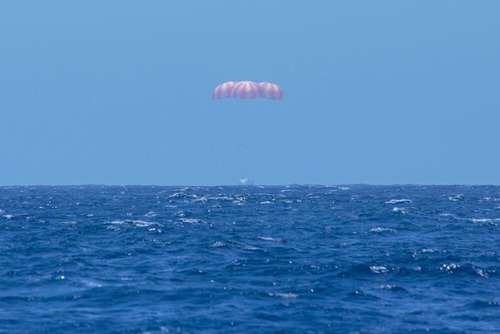 A SpaceX Dragon capsule splashing down in the Pacific Ocean Sunday, May 18, 2014. Reports indicate water was found inside the capsule after splashdown, but that it did not affect any of the cargo brought back from the station. (credit: SpaceX) The splashdown of SpaceX’s Dragon spacecraft in the Pacific Ocean off the coast of Baja California just after 3 pm EDT (1900 GMT) Sunday appeared to mark the end of the company’s third Commercial Resupply Services (CRS) mission to the International Space Station (ISS). All that SpaceX had to do was return the capsule by boat to Los Angeles, where some cargo would be offloaded and from them on the Texas for the rest.
By Tuesday morning, though, there were rumors flying around the space community that there was an issue with the Dragon spacecraft. Reports claimed that it took as long as 11 hours to retrieve the capsule from the ocean and place it on the boat, and that water was found inside the capsule, either salt water that leaked in or water from a payload or other equipment brought back from the ISS. Aviation Week was the first to formally report on the issue on Wednesday, citing multiple sources, and later verified by NASA.
Any water leakage in, or into, the capsule does not appear to have caused problems for the payloads returned from the station. “All early-return cargo was delivered on time Tuesday as planned and is in good condition,” NASA spokesperson Rachel Kraft said in an emailed statement on Thursday afternoon, in response to an earlier inquiry about the reported water intrusion issue. “Early-return cargo included about 660 pounds of ambient and cold stowage science samples for which all temperature requirements were met.”
“The remaining cargo from Dragon is on its way back to NASA facilities in Houston and is expected to arrive on Friday,” the statement continued. “Initial indications show no issues with the returned hardware, which will undergo normal inspection upon arrival in Houston.”
A SpaceX spokesperson did not respond to a request for comment on the issue on Tuesday.
 An illustration of Stratolaunch Systems’ proposed air-launch system, now called the Eagles Launch System according to a contractor’s press release. (credit: Stratolaunch Systems) Aerojet Rocketdyne is the latest company to become part of Stratolaunch Systems’ effort to develop a large air-launch system. The company announced Monday that it won a contract from Stratolaunch for six RL10C-1 engines, variants of the RL10 engines used on the upper stages of the Atlas V and Delta IV rocket. Those engines, which use liquid oxygen and liquid hydrogen propellants, will be used on the upper stage of Stratolauncher’s rocket, with two RL10’s per vehicle. The contract also includes an option for an additional six engines. Orbital Sciences is providing the lower stages of the rocket, using solid motors.
The announcement also includes some new nomenclature for Stratolaunch Systems’ vehicle, which typically has been called simply Stratolauncher. According to the Aerojet Rocketdyne press release, the overall launch system, both airplane and launch vehicle, is called the “Eagles Launch System,” while the rocket itself is called “Thunderbolt.” (The release does not indicate if the systems custom-built giant aircraft has its own distinct name.) Neither this nomenclature, nor the Aerojet Rocketdyne contract, is reflected on the Stratolaunch Systems website, where the latest press release is dated June 3, 2013.
After the The Sunday Times of London reported issues with the wings of the company’s WhiteKnightTwo (WK2) carrier aircraft, and the possibility that SpaceShipTwo (SS2) may fall short of the 100-kilometer “Kármán line,” the company has responded in a couple of ways. On the WK2 issue, the company tweeted a photo of WK2 on the runway at the Mojave Air and Space Port in California, undergoing taxi tests of its new landing gear:
The company makes no mention of the reported defects (be they “imperfections,” as the company called them, or “cracks,” as others cited in the Times report did) but there’s the subtle message that WK2 will—presumably—be back in the skies soon, with SS2 test flights to follow.
Another aspect of the Times report was that Virgin was only guaranteeing in its contracts that it would take people to altitudes of 50 miles (80 kilometers): an altitude that NASA and the US Air Force have used for granting astronaut wings but below the 100-kilometer mark the company had previously said SS2 flights would achieve. Virgin Galactic CEO George Whitesides responded to an inquiry from Gizmodo about the report by saying 100 kilometers was still the company’s goal. “As we have always noted, we will have to prove our numerical predictions via test flights as we continue through the latter phase of the test program. Like cars, planes, and every other type of vehicle designed by humans, we expect our vehicle design and performance to evolve and improve over time.”
The company also alerted its customers to the Times report before it was even published, Parabolic Arc reported, posting an email that Virgin Galactic’s Stephen Attenborough sent the day before the newspaper published the article. “We don’t know all the angles but from what we can tell, the story appears to be predicated on false or deliberately misleading and exaggerated rumours from ‘off the record’, nameless contributors,” he wrote. “Although that means we cannot be sure of the sources of the mischief, we suspect they are linked in some way to the author Tom Bower, who has made a living by trying to discredit famous personalities, including Richard.” (Bower, who wrote a critical book about Branson published earlier this year, was quoted in the article, but Parabolic Arc’s Doug Messier, a co-author of the Times article, said he did no reporting on it.)
Both Whitesides’s and Attenborough’s comments, though, offer some glimpses of what the company has planned. In his email to customers, Attenborough said that since the company had sent out a newsletter the previous week “we have successfully undertaken the first of the qualifying firings of the rocket motor in preparation for the rapid series of powered test flights,” which may be a reference to an engine test last Thursday. Whitesides told Gizmodo that that the first SS2 flight into space “will happen just a few short months from now” and that “our current timetable has Richard [Branson’s] flight taking place around the end of the year.”
Branson, in a recent interview with Bloomberg, also addressed the company’ delays. “We are really hopeful that we’re almost there, but we’ve got to put all of the pieces together and we’re not going to go until we’re 100 percent sure it’s safe,” he said. “I’ll be very, very disappointed if it doesn’t happen this year.”
A new company involving at least some former Armadillo Aerospace employees will unveil its plans on Wednesday. Exos Aerospace is holding a “ribbon cutting media event” Wednesday morning at the Caddo Mills (Texas) Municipal Airport, northeast of Dallas. That’s the airport where Armadillo Aerospace had operated for several years, developing vehicles and performing low-level flight tests.
The company hasn’t announced any more details in advance of Wednesday’s event, although, on Facebook, former Armadillo VP of operations Phil Eaton posted a brief comment and a link to a half-minute teaser video. “Come one come all, there will be tours, a live band, and a few comments from Congressman Ralph Hall,” he wrote. Hall, the former chairman of the House Science Committee, represents the Caddo Mills area in Congress.
Armadillo Aerospace had been in “hibernation mode” since last year, the company’s founder and chief funder, John Carmack, announced last August. Carmack later joined Oculus VR, a virtual reality company that Facebook acquired in March. Carmack later posted on Twitter that the Facebook deal gave him money to try again in aerospace, but that he had no plans to do so for “several years.”
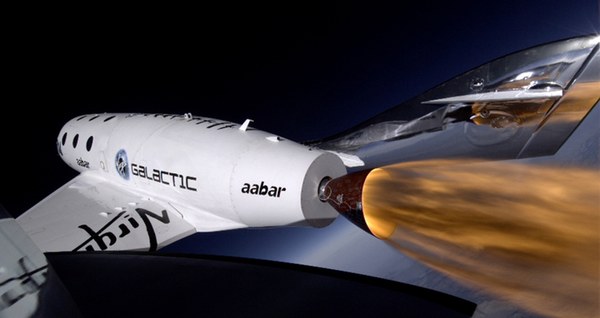 SpaceShipTwo fires its hybrid rocket engine during its third powered test flight on January 10, 2014. The next powered test flight of the vehicle is unlikely to take place before some time in June as its carrier aircraft undergoes repairs, according to a report. (credit: Virgin Galactic) It’s been a little more than a year since Virgin Galactic performed the first powered flight of SpaceShipTwo (SS2) in the skies above Mojave Air and Space Port in California on April 29, 2013. Since then, though, SS2 has made only two more powered flights: September 5 and January 10. While Virgin Galactic officials said at public forums in recent weeks that SS2 powered flights would resume soon, a new report suggests it may be some time before SS2 returns to the skies, let alone makes it into space.
According to a report in The Sunday Times of London today (subscription required), SS2’s carrier aircraft, WhiteKnightTwo (WK2), is grounded because of an issue with the aircraft’s carbon composite wings. The plane had been undergoing an annual inspection, as well as a replacement of its landing gear, when “defects” were found in the wings. The Times report cited sources that described the defects as “multiple cracks,” but Virgin Galactic CEO George Whitesides told the paper that they were “adhesive imperfections” created by extra glue sticking out where sections of the wing were joined together.
The co-author of the Times report, Doug Messier, publishes the Mojave-based Parabolic Arc that has closely tracked Virgin Galactic’s progress and setbacks. In a post this morning, he offers some more details about the wing issue, reporting that sources describe them as cracks (not, he notes, “imperfections”) running along the wing spars. “One particularly worrisome aspect is that nobody knows why or when they occurred,” he writes, adding that there is “some comfort in the repairs being made” because of Scaled Composites’ experience in repairing composite aircraft.
Be they cracks or imperfections, Whitesides said they had only a “negligible impact” on the strength of WK2’s long wing and the aircraft’s flying performance. The imperfections had been “buffed out” and the plane is scheduled to resume flights in the first week of June.
That schedule would suggest that the next opportunity for a powered flight of SS2 would not be until later in June, assuming that WK2 makes one or more test flights before carrying SS2 on a powered flight. That also assumes that SS2’s hybrid engine is ready as well: in the Times article, Whitesides said vibration issues with the motor had been resolved. (Messier reported Saturday that static engine tests continue, including one on Thursday.)
The Times article also raises another concern about Virgin Galactic. A copy of the customer contract obtained by the newspaper states that the company only guarantees to take people to an altitude of at least 50 miles (80 kilometers) above the Earth. That is below the “Kármán line” of 100 kilometers that used as the de facto boundary of space by many organizations, including the X PRIZE Foundation, who ran the Ansari X PRIZE won by SpaceShipOne in 2004. It’s also below what Virgin Galactic officials have publicly said as well, indicating that SS2 flights would go to at least 100 kilometers. The 50-mile mark, though, is the boundary used by NASA and the US Air Force in awarding astronaut wings, and the company told the Times “its goal was to reach 60 miles,” just below the 100-kilometer mark.
Virgin Galactic officials have, publicly, indicated that the company remains on track for flying into space later this year and beginning commercial flights before year’s end. Speaking at the American Astronautical Society’s Goddard Memorial Symposium outside Washington, DC, on March 6, Whitesides said that the company had been focused on outfitting the interior of SS2 while WK2 underwent an annual inspection. “We’re doing the groundwork for the fourth powered flight,” he said at the time. “We’ll have a few different flights before we get to the space altitude flight.” He didn’t specify when that next powered flight would take place.
At the Space Tech Expo conference in Long Beach, California, on April 3, Virgin Galactic vice president for special projects Will Pomerantz also didn’t provide details on when those powered test flights would resume, other than in the near future. “Our flights are scheduled to begin towards the end of this calendar year,” he said of when commercial service would begin.
Those initial commercial flights, though, may not carry tourists. Later in his Space Tech Expo presentation, Pomerantz said that “some of our first flights, perhaps our first commercial flights period, will be for NASA through the Flight Opportunities program, flying engineering and technology demonstration payloads.” He said later those flights would be dedicated flights—that is, no mixing of tourists and experiments—which could allow the company to build up more flight experience before ramping up tourist flights.
As recently as last week, Virgin founder Sir Richard Branson said the company was still on track to begin commercial SS2 flights—with him on board the first one—this year. “As always, safety will ultimately call the shots, but right now, I’m planning to go to space in 2014!” he told Reuters last week in an email.
In the Times article, though, Whitesides is more cautious. “We have got a good shot at getting Richard to space this year, but we are not going to be rushed,” he says. “We are doing it right and we are taking our time.”
“We’re late, there is no question,” he added.
SpaceX has postponed a launch previously scheduled for Saturday of six commercial communications satellites because of an unspecified problem during an attempted static fire test, delaying the launch until late this month.
“A static fire test in advance of SpaceX’s ORBCOMM OG2 Mission 1 was scrubbed this morning during fueling,” the company said in a brief statement emailed (after some delay) Friday afternoon. “Both the Falcon 9 rocket and ORBCOMM satellites are in good condition but as a result of schedule constraints, [the] launch will be postponed past this weekend with the next opportunity most likely in late May.”
SpaceX had planned to launch the Falcon 9 v1.1 Saturday at 9:47 am EDT (1347 GMT), placing the six ORBCOMM Generation 2 (OG2) satellites into low Earth orbit. The satellites are part of a system of 17 such satellites that will replace the existing constellation used by satellite communications company ORBCOMM to provide data services around the globe. The OG2 satellites, built by Sierra Nevada Corporation, weigh 170 kilograms each and provide higher communications throughput compared to the original ORBCOMM satellites. The OG2 satellites also carry Automatic Identification System (AIS) payloads, a means of tracking ships.
Had Saturday’s launch gone off as planned, it would have been the fastest turnaround between Falcon 9 launches to date for SpaceX, coming just 22 days after it launched a Dragon cargo spacecraft for NASA. While SpaceX hasn’t disclosed details about the delay, part of a slip to late May would be due to range conflicts at Cape Canaveral: a Delta IV rocket is scheduled to launch a GPS satellite on May 15, while an Atlas V will launch a classified satellite on May 22. In any event, the delay further constrains SpaceX’s previously announced plans to perform ten launches this year, as this mission will be only the third Falcon 9 launch of 2014. The company will need some turnarounds between launches as fast as what was originally planned—and some luck, too—to achieve that goal now.
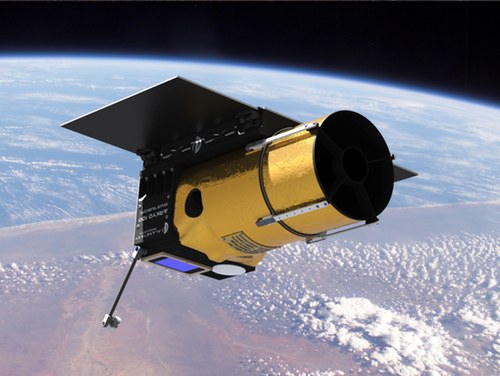 Illustration of a Planetary Resources Arkyd-100 spacecraft in orbit. A company official showed last month a larger version of the larger Arkyd-200 series that could launch as soon as late 2015. (credit: Planetary Resources, Inc.) The Wall Street Journal yesterday reported what it considered a bit of a scoop: that asteroid mining company Planetary Resources had pivoted on its business plan. “Now, largely without publicity, the team of former National Aeronautics and Space Administration officials that runs Planetary Resources has shifted the company’s focus to a more mundane space resource: water,” the Journal reported in an article headlined “What Happened to That Crazy Asteroid Mining Plan?”. According to the Journal, the company was now focused extracting water from asteroids to use as propellant.
There’s just once problem with that breaking development: it’s not new. Indeed, since the company unveiled its plans a little more than two years ago, the company has emphasized plans to extract water from asteroids for use as propellant. “If we were able to provide that propellant for a price of one-tenth of the effective cost of bringing it from the Earth, that would shave off a large portion of the cost of going into deep space,” company co-founder Eric Anderson told me in an interview just before the company announced its existence in April 2012. So that shift in focus the Journal crowed about was not really a shift at all.
But don’t trust just me. “At an event at the Seattle Museum of Flight, a group that included former National Aeronautics and Space Administration officials unveiled Planetary Resources Inc. and said it is developing a ‘low-cost’ series of spacecraft to prospect and mine ‘near-Earth’ asteroids for water and metals,” the Journal reported about Planetary Resources in April 2012 (emphasis added).
The company also hasn’t abandoned interest in extracting other resources from asteroids. In a presentation during a space panel at the AwesomeCon science fiction convention in Washington, DC, last month, Peter Marquez, vice president of global engagement for Planetary Resources, said the company was also interested in extracting metals, in particular platinum-group metals, from asteroids.
At that panel, Marquez did reveal a different, more technical, shift in the company’s work. He revealed a new design for the company’s Arkyd-200 series of spacecraft that he dubbed “HomerSat,” after cartoon character Homer Simpson and his love of donuts. “It’s a telescope wrapped in fuel tanks,” he said of the design, showing a telescope surrounded by two toroidal propellant tanks. “It looks like two donuts stuck on top of each other.”
Those propellant tanks give the spacecraft, weighing a couple hundred kilograms, as much as 5 kilometers per second of delta-v, making it very maneuverable. “We can scoot around quite a bit, quite often,” Marquez said.
That Arkyd-200 spacecraft could launch as soon as late next year, he said, although the company was still working on launch arrangements. A small prototype satellite is scheduled to be launched later this year from the International Space Station.
|
|








Recent Comments